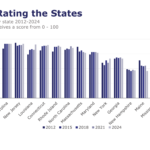Most financial firms aren’t assessing their portfolio exposure to nature-related risks with the same urgency they use to measure climate impacts, a shortcoming that could lead to higher costs, litigation and a hit to reputations, according to a new report.
Only 20 percent of financial companies measure their exposure to nature-related risk compared to the 85 percent who calculate their potential vulnerability to climate impacts, according to the report by CDP, which helps companies disclose environmental impact. The analysis was based on disclosures made to the nonprofit last year by more than 550 banks, insurers and asset owners representing about $8 trillion in market capitalization.
“Consideration of nature is not yet a priority for most” finance firms, said CDP. They “remain largely blind to the risks.”
One of the key risks is higher costs. BNP Paribas SA told CDP that if banks are seen to be contributing to deforestation, they could face potential financial risks “in the order of 25 percent of their market value” arising from litigation, reputation loss and other factors. Financial institutions are also exposed as a result of their lending and underwriting activity to businesses. The World Economic Forum estimates that $44 trillion of economic value generation – over half of the world’s total GDP – is moderately or highly dependent on nature and its services.
Since the signing of the Paris climate agreement in 2015, banks and money managers have faced growing pressure to gauge the threat posed by a warming planet, as well as their contribution to it. Yet researchers have also warned that the main goal of the pact — to limit warming to 1.5C — can’t be met without protecting and restoring nature. Land-based and marine ecosystems, for example, currently absorb half of the human-made carbon emissions and play a vital role in regulating the climate.
The finance industry’s response to nature risk has been lackluster so far. CDP found while nearly 95 percent of finance firms said their business strategies or financial planning are now “influenced” by climate change, less than a third give similar attention to forest issues and water security. That mirrors the focus of their boards on the topic: 91 percent of financial institutions reporting to CDP have board-level oversight of climate-related issues, compared to 32 percent with oversight of forests and water-related topics.
A separate analysis by Jefferies shows the finance industry is lagging non-financial corporations in awareness and preparedness for freshwater scarcity. Finance firms “see these issues as important but not an immediate priority,” CDP said.
There is impetus for change. A recent international agreement on biodiversity, described as the Paris accord for nature, could persuade investors to take nature-related risks more seriously. And several companies, including BlackRock Inc., UBS Group AG and HSBC Holdings PLC, have backed the Taskforce on Nature-related Financial Disclosures, a framework for organizations to report and act on nature-related risks.
CDP also offered examples of what it considers best practice. In Brazil, Banco Santander SA monitors how vulnerable its clients are to water scarcity. The Dutch insurer Aegon, meanwhile, expects investee companies to assess and manage how their activities can drive deforestation or biodiversity loss.
Photograph: Pine trees stand in a forest near the site of the Tesla Inc. factory in Gruenheide, Germany, on Feb. 23, 2020. Photo credit: Krisztian Bocsi/Bloomberg





















 Time-Tested Loss Reserving Methods Challenged: AM Best
Time-Tested Loss Reserving Methods Challenged: AM Best  USAA to Lay Off 220 Employees
USAA to Lay Off 220 Employees  IBHS: Virginia Edges Florida Out of First Place in Building Code Adoption
IBHS: Virginia Edges Florida Out of First Place in Building Code Adoption  Munich Re Specialty Launches FAIR Plan Commercial Wrap Product in California
Munich Re Specialty Launches FAIR Plan Commercial Wrap Product in California 



